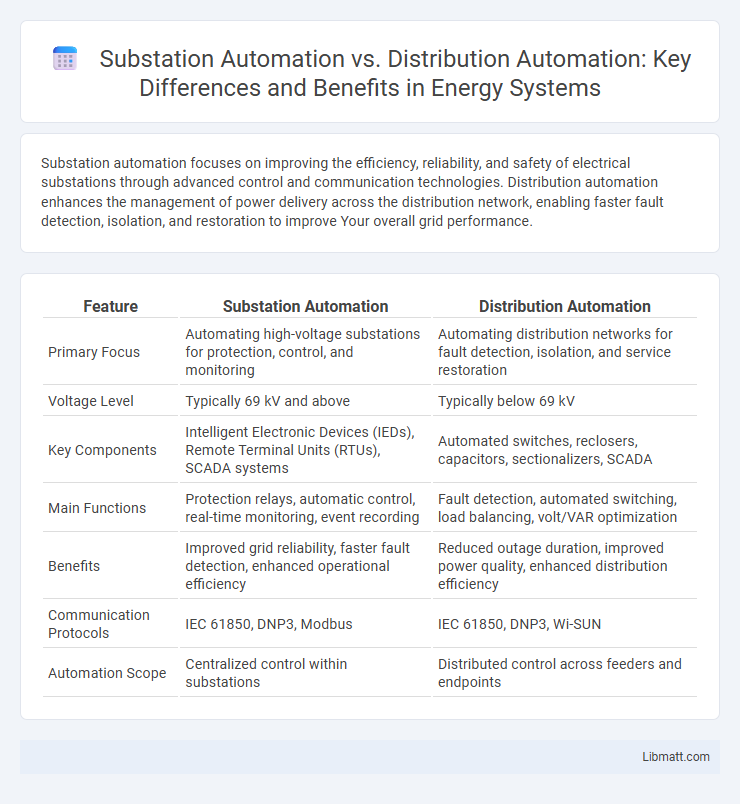Substation automation focuses on improving the efficiency, reliability, and safety of electrical substations through advanced control and communication technologies. Distribution automation enhances the management of power delivery across the distribution network, enabling faster fault detection, isolation, and restoration to improve Your overall grid performance.
Table of Comparison
| Feature | Substation Automation | Distribution Automation |
|---|---|---|
| Primary Focus | Automating high-voltage substations for protection, control, and monitoring | Automating distribution networks for fault detection, isolation, and service restoration |
| Voltage Level | Typically 69 kV and above | Typically below 69 kV |
| Key Components | Intelligent Electronic Devices (IEDs), Remote Terminal Units (RTUs), SCADA systems | Automated switches, reclosers, capacitors, sectionalizers, SCADA |
| Main Functions | Protection relays, automatic control, real-time monitoring, event recording | Fault detection, automated switching, load balancing, volt/VAR optimization |
| Benefits | Improved grid reliability, faster fault detection, enhanced operational efficiency | Reduced outage duration, improved power quality, enhanced distribution efficiency |
| Communication Protocols | IEC 61850, DNP3, Modbus | IEC 61850, DNP3, Wi-SUN |
| Automation Scope | Centralized control within substations | Distributed control across feeders and endpoints |
Introduction to Power System Automation
Power system automation integrates advanced technologies to enhance the monitoring, control, and protection of electrical networks. Substation automation specifically targets the digital management of equipment within substations, enabling faster fault detection and improved reliability. Distribution automation expands this concept to the entire distribution network, optimizing load management and improving service restoration for your electrical supply.
Defining Substation Automation
Substation Automation refers to the integration of intelligent electronic devices (IEDs) and communication networks within electrical substations to monitor, control, and protect high-voltage equipment efficiently. It enables real-time data acquisition, fault detection, and automated switching operations, enhancing grid reliability and operational efficiency. Unlike Distribution Automation, which focuses on the low-voltage distribution network, Substation Automation is centered on managing the critical infrastructure within substations to ensure optimal power flow and system stability.
Understanding Distribution Automation
Distribution Automation enhances the efficiency and reliability of electrical distribution networks by integrating real-time monitoring, control, and data analysis technologies. Unlike Substation Automation, which focuses on automating the operations within the substation environment, Distribution Automation extends control capabilities to feeder lines and end-user connections, improving power quality and reducing outages. Understanding Distribution Automation allows you to optimize grid performance, minimize downtime, and proactively manage fault detection and isolation across the distribution network.
Key Differences Between Substation and Distribution Automation
Substation Automation focuses on the monitoring and control of high-voltage substations, managing equipment like transformers, circuit breakers, and protection relays to ensure system reliability and fault detection. Distribution Automation primarily optimizes the medium- and low-voltage distribution network by automating switches, reclosers, and capacitor banks for improved power quality, outage restoration, and load balancing. Understanding these key differences helps you choose the right technology for enhancing grid efficiency and resilience at different levels of the electrical supply chain.
System Architecture Comparison
Substation automation systems typically feature centralized control with intelligent electronic devices (IEDs) communicating through protocols like IEC 61850, enabling real-time monitoring and protection within the substation. Distribution automation architectures emphasize decentralized control with distributed intelligence across feeders and transformers using advanced sensors, automated switches, and SCADA integration to enhance operational efficiency and outage management. Your choice between these architectures depends on the scale and complexity of your grid, as well as the need for rapid fault detection and adaptive load management.
Communication Technologies Utilized
Substation automation primarily relies on IEC 61850 communication protocols, enabling high-speed data exchange and interoperability among Intelligent Electronic Devices (IEDs) within substations. Distribution automation utilizes a mix of communication technologies such as SCADA systems, wireless mesh networks, and Fiber Optic Communication to monitor and control distribution network elements. Both systems emphasize real-time data transmission but differ in protocol implementation and range, with substations focusing on local device integration and distribution automation covering broader, geographically dispersed areas.
Benefits of Substation Automation
Substation automation enhances grid reliability by enabling real-time monitoring, control, and fault diagnostics, which reduce outage durations and maintenance costs. It supports advanced analytics and remote operation, improving operational efficiency and asset management in electrical substations. The integration of intelligent electronic devices (IEDs) within substation automation systems also boosts system protection and faster fault detection, leading to increased power quality and safety.
Advantages of Distribution Automation
Distribution Automation enhances grid reliability by enabling real-time monitoring and fault detection, which minimizes outage durations and improves service continuity. It optimizes energy flow and reduces operational costs through automated switching and load management, increasing overall efficiency. Your utility benefits from faster response times and improved power quality, supporting better demand management and integration of renewable energy sources.
Challenges and Considerations in Implementation
Substation automation faces challenges such as integrating legacy equipment with modern intelligent electronic devices (IEDs) and ensuring cybersecurity across critical control systems. Distribution automation requires overcoming complexities in real-time data management and coordinating distributed energy resources (DERs) while maintaining grid stability. Implementing both systems demands careful consideration of interoperability standards, communication infrastructure, and the scalability to support future smart grid advancements tailored to your operational needs.
Future Trends in Power Grid Automation
Future trends in power grid automation emphasize advanced analytics, edge computing, and AI-driven decision-making to enhance both Substation Automation and Distribution Automation. Substation Automation focuses on real-time monitoring and control of high-voltage equipment, while Distribution Automation integrates smart sensors and automated switchgear to improve reliability and outage management at lower grid levels. Your energy infrastructure benefits from these innovations by achieving higher efficiency, minimized downtime, and seamless integration of renewable resources.
Substation Automation vs Distribution Automation Infographic

 libmatt.com
libmatt.com